“Focus on the Future” – City Branding of Mississauga in Ontario, Canada. Case study by David Ferreira, Jeannette Hanna and Malcolm Allan on how to develop a city brand strategy.
David Ferreira is the Brand Manager for the City of Mississauga in Ontario, Canada; Jeannette Hanna is the strategy Director for trajectory, a brand strategy and design agency based in Toronto, who led the consulting team that developed the city’s brand strategy; Malcolm Allan is the founder and managing director of Placematters, a UK place brand strategy consultancy, based in London, who provided advice on city branding strategy and practice.
Learn about:
- How Mississauga, Canada’s sixth largest city, is reshaping its image beyond the shadow of nearby Toronto;
- Mississauga’s strategy to attract international talent and investment;
- The lessons from Mississauga’s approach to initiating, creating and implementing a place brand proposition;
- Initial challenges of the city branding initiative and how they were overcome;
- The research phase;
- The implementation – bringing the Mississauga brand alive;
- Key lessons and city brand strategy advice.
When you are a young, fast-growing urban centre on the border of one of North America’s largest cities, promoting yourself to the world can have its challenges. But Mississauga, Canada’s sixth largest city, is reshaping its image beyond the shadow of nearby Toronto – less than 30 km away – as a magnet for international talent and investment in its own right.
A key strategy in fueling the city’s already impressive momentum is a multi-year brand-building commitment. This post examines the lessons from Mississauga’s approach to initiating, creating and implementing a place brand proposition that’s been broadly embraced by diverse stakeholders and the community at large.
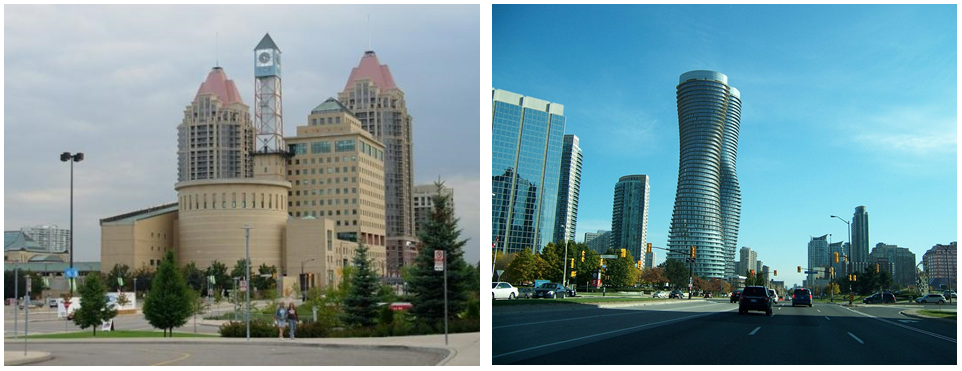
Clearly, Mississauga has a lot going for it. Global businesses, regional start-ups, and residents from around the world are drawn to its high quality of life, excellent programmes and services and welcoming atmosphere. It’s a very different place than when it was first established as a municipality in 1974.
Back in 1974, residents numbered less than 222,500. Today, the city’s population has tripled to 757,000, making it not only Canada’s sixth biggest metropolis but one of its most culturally diverse as well. It’s home to 63,000 businesses, 71 leading Fortune 500 companies, two leading community hospitals, and two renowned post-secondary institutions.
Mississauga has won numerous citations for its future-friendly attributes including: Top employer for young people and newcomers (2012 Mediacorp Canada Inc.’s “Canada’s Top 100 Employers”) and Best Overall Mid-sized City of the Future (2013 Foreign Direct Investment Magazine’s American Cities of the Future).
Mississauga enjoys the kind of global connections and cultural diversity of cities more than twice its size in North America – a huge advantage for its businesses and people.
Mississauga continues to grow and transform itself in exciting ways. It has an ambitious and aspirational vision for the future. However, outdated perceptions often lag behind reality and can be difficult to change. Beyond its own borders, many people continue to view Mississauga as simply a suburban bedroom community. City leaders agreed it was time to tackle the problem head on.
Initiation: Making the case for place branding
The goals for the project included:
- Competing more effectively for investment from business and other levels of government;
- Recruiting talent and job-creating organizations to the area;
- Attracting customers, visitors and residents;
- Encouraging innovative and sustainable development that supports the city’s long-term vision;
- Promoting Mississauga’s downtown as a dynamic place to live, work, learn and play;
- Enhancing the city’s reputation as a great place to live and work and as destination to explore.
In May 2013, the City of Mississauga in Ontario commissioned (via a competitive bid process) Toronto-based brand strategy consultants Trajectory to develop a brand proposition for the city and a parallel strategy for the city’s downtown area. The project team, led by the City’s Communications Division, also included researchers from The Strategic Council and London-based place brand strategists Placematters.
David Ferreira, Brand Manager at the City of Mississauga, was the project manager for the initiative.
For David, Mississauga is “…a young and modern city actively defining its brand story; a compelling story which we need to communicate clearly and reflective of the city today.”
The Communications Master Plan approved by City Council identified the need to develop a strong, unified brand reputation for the City that is rooted in its strategic vision. This was the first thorough review of Mississauga’s brand story and reputation and the first time in almost 30 years that we have refreshed our visual identity program.
Initial challenges
As project manager, David Ferreira helped ensure key project sponsors were highly engaged in the process. For example, the Mayor and each city councillor participated in one-on-one interviews to reinforce the value of the initiative and to ensure local community concerns were captured at the outset of the process.
As David notes, aligning support around a city story versus a government story was key. “The first big challenge was shifting the brand focus from that of the City of Mississauga – a municipal ‘corporation’ – to Mississauga the city, a destination of choice for residents, workers, employers, visitors, students and more.”
“The challenge was multi-layered: Create a compelling story to embrace the scale and scope of the city as a whole; distinctly position Mississauga’s emerging downtown core within the larger brand story; galvanize internal audiences – city employees, key partners, and residents to become ambassadors for their brand story.”
Consultation and engagement
In developing its Strategic Plan, Mississauga had already garnered input from close to 100,000 participants. That provided a rich foundation for more targeted brand research.
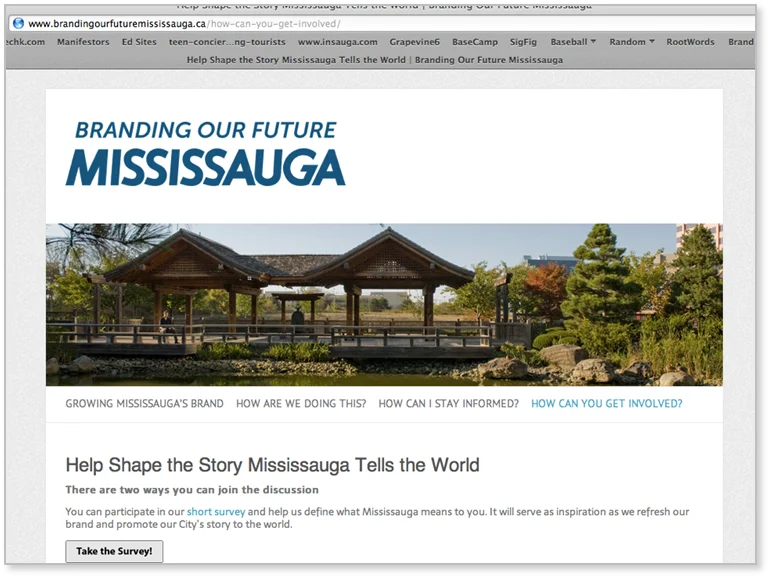
The engagement phase of the project included survey input from 500 residents and 100 small businesses, 23 one-on-one interviews with the City of Mississauga Council, the City Leadership Team, regional leadership and community partners, plus four brand development workshops with over 100 participants.
Workshop participants – including city staff, residents, businesses, and community partners – acted as the Brand Advisory Panel.
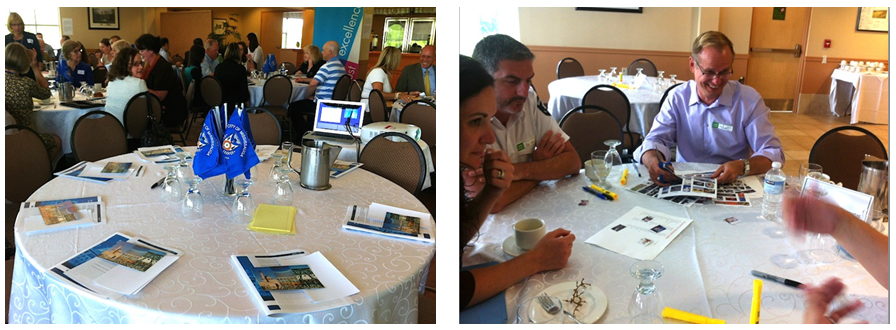
The process was rooted in evidence-base insights used to create the brand “building blocks” or key story elements and scenario planning techniques to assess different approaches to shaping the Mississauga story.
 Each workshop built on the insights of previous sessions and were designed to help the panel:
Each workshop built on the insights of previous sessions and were designed to help the panel:
- Understand what’s involved in brand strategy development;
- Think about future trends and changes Mississauga should anticipate;
- Understand perceptions of Mississauga today and its aspirations for the future;
- Consider audiences of the future to promote the City and its downtown;
- Prioritize actions to realise the city’s vision;
- Identify key messages the brand proposition should communicate;
- Explore Mississauga’s core brand ingredients, attributes and points of differentiation
Taking into account future realities
As a growing city, anticipating future realities was an important part of the brand deliberations. Some of the projections and indicators of note that the panel considered included:
- By 2031, Mississauga’s population will have grown significantly: City: from 757,000 to 812,000 residents; Downtown: from 32,000 to 70,000 residents.
- By 2031, Mississauga’s population will have aged significantly: 300,000+ residents age 55 or more. Canada’s largest population group will be Baby Boomers aged 55 to 65 by 2020.
- By 2031 Mississauga’s population will be more diverse: About one-third of Canada’s population will be a visible minority. Canada’s Aboriginal population is also growing at twice the rate of general population and moving into urban centres.
- Mississauga residents’ first language: English: 47.6% (68.2% for Ontario); French: 1%; Neither English or French language: 47% (25.7% for Ontario); Top 5 non-official languages in Mississauga: Urdu, Polish, Punjabi, Arabic, Tagalog.
Existing perceptions
Key research findings from quantitative survey data affirm that the perceptions of local residents and businesses are very positive, both in terms of it being an excellent place to live and in terms of economic prosperity.
Residents, business owners and stakeholders identified a number of key advantages that they feel make Mississauga an attractive location, including:
- Open and welcoming communities
- Ideal place to raise a family
- Culturally diverse and globally connected
- Located in the heart of one of North America’s most vibrant regions
- Offers residents and visitors a high quality, balanced lifestyle
- Surrounded by natural beauty and open spaces
- Economically prosperous with a strong base of employment
- Young city on the cusp of something big
- Exciting opportunities for growth, for the city and its residents
Research also found that local perceptions of the inspiring possibilities make people passionate about Mississauga. They express a strong shared vision, a “can do” spirit and commitment to excellence that makes great things happen.
Developing Mississauga’s brand story
David Ferreira reinforces the importance of fact-based engagement in creating a robust Mississauga story: “The workshops were critical in finding common ground among the diverse perspectives that the brand must represent – from libraries, planning, parks and recreation to local villages, resident associations, small businesses and educational institutions to name only a few.”
Research and the deliberations of people on the panel identified that people choose Mississauga for many reasons and focused on three qualities that knit the social, cultural and economic life of the city together in a unique way and could be supported by compelling proof points:

These three core elements are expressed in a clear, compelling Mississauga brand story that now acts as the foundation for all of the city’s external marketing and communications.
The Downtown brand also leverages the same three core ingredients but grounds them in proof points that showcase downtown as a vibrant, multi-use, connected and innovative community.
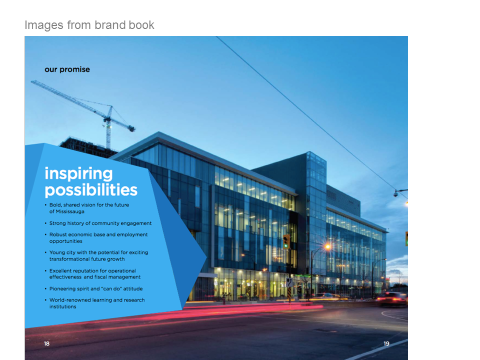 Once the brand proposition was tested and validated by internal staff and external stakeholder groups, the city’s current logo and visual identity were tested to determine whether they accurately reflected Mississauga’s new proposition.
Once the brand proposition was tested and validated by internal staff and external stakeholder groups, the city’s current logo and visual identity were tested to determine whether they accurately reflected Mississauga’s new proposition.
The Brand Advisory Panel overwhelmingly responded that the current logo did not resonate with the new direction, was too corporately focused and did not represent the city overall. They also expressed that the current visual identity didn’t effectively portray the city’s defining attributes and experiences, nor its aspirations for the future.
As a result, Mississauga’s internal Creative Services staff, supported by the consulting firm’s design team, created a streamlined flexible identity system to better reflect Mississauga’s ambitious aspirations.
Based on input from the Brand Advisory Panel, the positioning and visual identity were further validated by residents through a series of online and in-person focus groups. This was done to confirm that the final recommendations accurately reflected the city’s brand story, and that it resonated with residents, businesses and other key audiences.
Implementation: Bringing the brand to life
A great strategy can only be as effective as its implementation. The project team developed a four-year brand implementation plan, based on four key principles to help guide the brand implementation and marketing strategy for the Mississauga and Downtown brands:
- Proactively manage all relevant promotional tactics and brand touch points to ensure alignment and consistency;
- Support and encourage internal and external marketing and ensure communication efforts are ‘on-brand’ to increase the strength of the brand overall;
- Develop new tools, templates, and systems to improve the effectiveness of the brand’s reach to target audiences;
- Enable residents, visitors and other key stakeholders to advocate and share their unique Mississauga moments and experience, nurturing a higher degree of excitement and civic pride.
Together, the initiatives outlined in the plan create an integrated, focused and targeted approach to promoting, marketing and communicating about Mississauga. It provides the City and its strategic partners with the tools and framework to proactively manage and strengthen Mississauga’s reputation and promote it as a dynamic growing city. This will help ensure the city’s continued success in attracting residents, talented young people, businesses, investment and tourists in an ever more competitive landscape.
In addition to identifying specific brand metrics to track, the project team proposed a number of innovative implementation opportunities as well:
- Create an internal “experience master planning” process
- Create an internal “idea incubator” process
- Create an internal on-brand recognition program
- Create the Mississauga Brand Partnership with key external stakeholders
- Develop a process for identifying “signature” initiatives
All of the recommendations were developed to balance fiscal responsibility with the need to deliver and promote a strong, consistent message to all audiences.
While still in the initial phases of a multi-year plan, David Ferreira sees significant progress already: “While the visual identity has been rolled out, many of the conceptual projects are still in development. New initiatives – for example the Downtown Exchange District project focused on a more walkable downtown – are being used as proof points of the new brand positioning.”
“Internally, the positioning and new identity have been very positively received. Externally, the brand positioning has helped spark many new conversations and collaborations with educators, including Mississauga’s major post-secondary institutions. Economic development partners have adopted the core messaging to actively promote Mississauga and its Downtown. The city is actively exploring new signature events with key partners.”
David sees implementation as a learning process: “For the first time we have a solid and well-articulated foundation for the Mississauga brand story. That story will grow and evolve, as it should, organically. But the future will be about refining the messaging. It has the right balance of current authenticity while capturing our future aspirations. For Downtown especially, the brand has all the elements of growth and possibility.”
Lessons learned
In terms of advice for others, David itemizes a number of critical success factors in the process of developing the brand proposition: “Senior leadership stewardship and visible support; internal engagement and alignment; the decision of the City to act as a catalyst for brand collaboration; a focus on planning for the long-term; coordinating messaging and marketing across all groups promoting Mississauga; measuring the impact of the brand to provide feedback; and celebrating success.”
David cites CEO’s for Cities’ Branding Your City report for its principles of measuring the success of a city brand:
- Monitoring the success of branding efforts with key audiences;
- Measuring the effectiveness of branding and marketing activities over time;
- Showing the effect the brand has on other areas (i.e. business, tourism, education, etc.) by measuring brand metrics in conjunction with key economic and community development metrics.
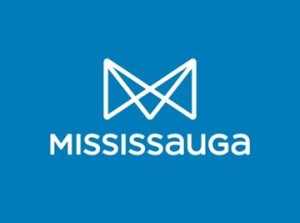
“We realize that the brand is a key influencer of the long-term success of the city,” he explains. “However, it’s hard to quantify its impact directly on key issues like international investment, business relocations, attracting residents. We have therefore identified a number of ‘proxy’ metrics that will help us monitor how well the brand is being embraced on a number of dimensions.”
“The overall goal of the brand is to drive choice and create loyalty and pride among our key audiences: current and potential residents, workers, employers, students, youth, visitors, investors, and partners. These metrics can be divided into two main categories. The first category reflects indicators that measure the success and reach of brand promotional efforts and initiatives while the second measures changes in key strategic outcomes for the City.”
Asked if he is happy with the progress that’s been made in promoting the brand proposition, David responds: “Part of the Mississauga value proposition is strong fiscal management and appropriate use of resources.”
We think we’ve achieved a good balance in continuing to work the implementation plan very methodically. The brand acts as a catalyst for us to be much more proactive with integrated marketing and communications for the city.
We have a multi-year horizon to work with. For example, Mississauga has been designated as Creative City for 2018. The brand helps people understand how to work with these kinds of opportunities.
Ultimately, the success of Mississauga’s brand strategy depends on how well it’s embraced by stakeholders. David underscores that fact, saying “Everyone needs to be accountable. We are the stewards of the brand. Our stakeholders need to be ambassadors so we must ensure the story speaks to them and give them the tools and resources they need – a brand book, key messages, guidelines – to share the story effectively.”
More information
A copy of the Mississauga Brand Book can be downloaded at mississaugabrand.ca
David Ferreira, Brand Manager of the City of Mississauga can be contacted at david.ferreira@mississauga.ca and on 01 905 615 3200 ext 5045
For more about Placematters, visit placematters.co or read our interviews with Malcolm Allan and Jeannette Hanna.
More about Trajectory on trajectoryco.com
Enjoyed this case study on developing a city brand strategy – example of Mississauga in Canada? Share and spread the word!


